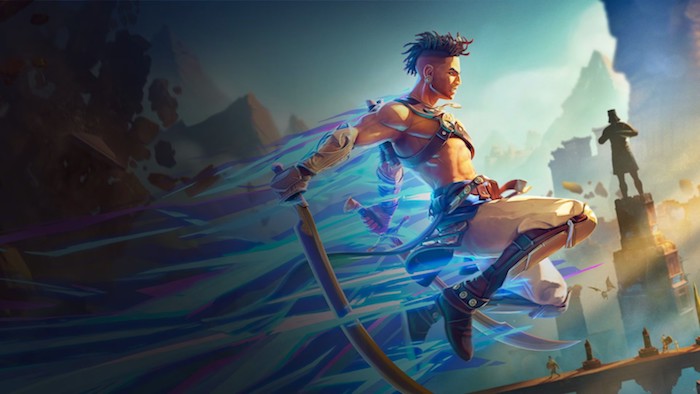Although many of today’s gamers may think of Prince of Persia as being a 3D, action-adventure series with heavy platforming elements, the truth of the matter is that the series began life as a 2D, sidescrolling, platformer way back in the late 80s. Since then, it’s changed and evolved with time, and also had a stint on the silver screen.
Fast-forward to today, where we’ve got a new series entry to play. One they call Prince of Persia: The Lost Crown. It’s a brand new project that is different from its most recent peers, choosing to eschew 3D action adventuring in favour of more classic, 2.5D, gameplay, which hearkens back to its roots. The result is a colourful, challenging and fun, Metroidvania style, experience.
Prince of Persia: The Lost Crown is the story of Sargon; the youngest member of a group of seven revered warriors, who are called Immortals. It begins as Persia is under attack, and sees the city struggling to fight back against those who threaten it. Enter the Seven Immortals, who make quick work of the attacking forces and become revered as a result. The problems don’t end there, though, because it isn’t long before young Prince Ghassan is kidnapped by a trusted someone, and taken to a previously inaccessible location called Mount Qaf.
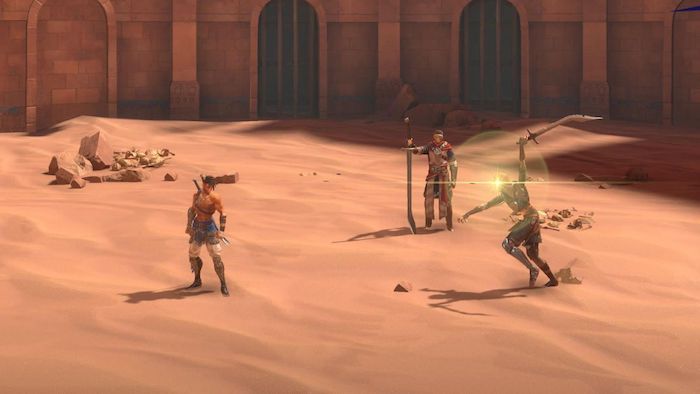
When Sargon and his peers follow the kidnappers and the one who was kidnapped, they discover that Mount Qaf isn’t all it seems to be. In fact, there’s something wonky about how time flows there. It doesn’t help that the area is full of enemies of varying types, not to mention environmental traps and acid baths.
What follows is a lengthy, Metroidvania style Prince of Persia game, where good platforming skills are rewarded. You’re essentially dropped into a massive, undocumented space, wherein there are lots of pathways and a number of dead ends. Searching everywhere will reveal secrets, but you won’t always be able to take advantage of them at that time, which makes the fact that you’re able to take a snapshot of such areas very helpful. That way, you can know to come back to it, and with which upgrade to do so.
The majority of this 20-25 hour-long experience is based around exploring Mount Qaf using platforming staples like wall jumps, slides, dashing and avoiding dangerous obstacles. There are times where it’ll really test your mettle, as well as moments where it’ll frustrate you; such as when a specific type of enemy captures you and sends you to jail, from which you must break out and find your way back to where you were. The map is large, it’s varied, and it can be easy to get lost and frustrated, as I did early on. I ended up in acidic sewers, where I couldn’t find a way to progress further and kept dying, which would send me way back to my last checkpoint. I got annoyed, and was cursing the game, but then I discovered that I’d missed climbing something elsewhere, which triggered a cutscene and progressed the story. Not only that, but it gave me a new way to go.
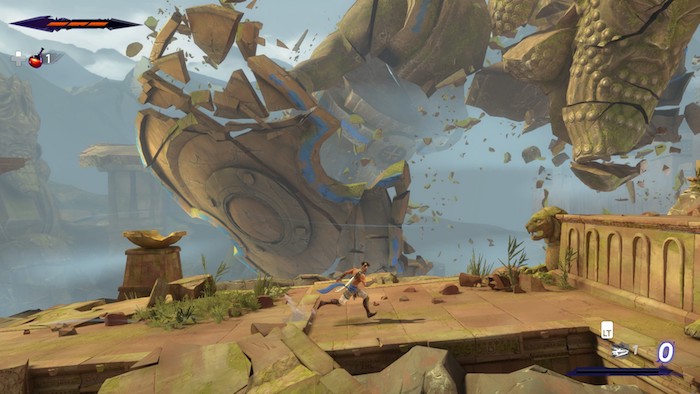
Complementing this tight, and sometimes rather challenging, platforming is a very stylish combat system that is as fast as it is visceral. Sargon is a competent fighter from the start, and he’s well trained in the ways of sword combat. He’s able to swiftly slash enemies apart, and can also parry their attacks, which is relayed to the player using the colour yellow. Missing a parry does leave you vulnerable to attack, though, and the enemies in The Lost Crown hit hard. In fact, this is a pretty challenging game, which makes it a good thing that you can customize the difficulty as you see fit, using different sliders.
There are also a number of unique boss battles, all of which will test your mettle. You’ll have to watch and learn their attack styles, and keep an eye out for attempts to parry. On easier difficulties it’s possible to spam them with hacks and slashes, but the more challenging difficulties obviously require more thinking and finesse.
As you play, you’ll fill a gauge and gain access to Sargon’s Athra Surge abilities. These are essentially special attacks, which can do good damage against enemies when used. For instance, one is a tornado-like spin-o-rama which is very helpful.
There are different levels of Athra Surge abilities, and you’ll need to fill the gauge enough to trigger the one you want. Unlocking different ones will also require effort, because they’re sometimes spread throughout the map as collectibles of sorts. Don’t expect to be able to use them as soon as you pick them up, either, because you have to return to special trees (which act as checkpoints) in order to change your loadout, so to speak.
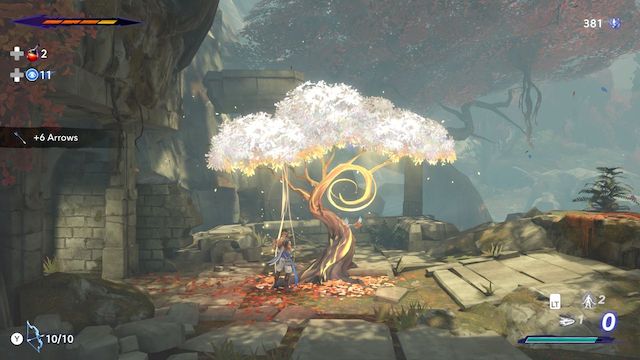
You’ll also find shop(s), where you can turn in discovered crystals in exchange for upgrades, the ability to carry more health potions and things like that. This includes flower petals; four of which will increase your health bar. These can also be earned as rewards for defeating bosses. Meanwhile, you’ll eventually find a bow, and become able to throw a disc, both of which help you reach new areas.
If you fail in battle, you’ll be returned to one of these trees. It’s a good system, which works fine because there are generally a bunch of trees and they’re not too far between. I thought they were more limited than they are, because I didn’t find one when I got stuck, as I mentioned above. Once I realized I’d been going the wrong way for 30 minutes, and figured out where to go to progress, it stopped being an issue.
All of the above is complemented by diverse, themed, regions of Mount Qaf. Each one introduces something new, too, like poison pits or a librarian who you must sneak by in order to avoid triggering. That’s not even mentioning the jerks who send you to jail. Furthermore, each area introduces new types of enemies, be they soldiers, flying beasts or scholars who’ve gone mad.
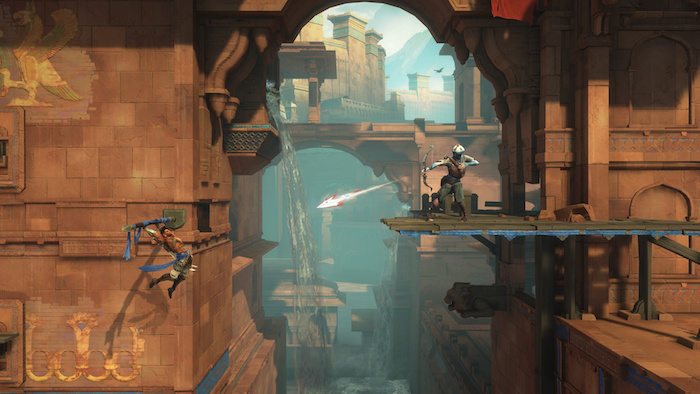
I guess it goes without saying, due to the above, but the gameplay found in Prince of Persia: The Lost Crown is very solid and well worth checking out, especially given that this game is cheaper than most of its peers. That said, the story and writing aren’t up to the same level. Some of the dialogue can be quite cheesy, and the narrative didn’t hook me as much as the gameplay did. That’s fine, though.
Like Prince of Persia 2008, The Lost Crown is a very colourful game with its own unique art style. One that’s been inspired by the likes of anime, superhero comics and street art, according to the developers at Ubisoft Montpellier. It all comes together really well, in a way that is both visceral and easy on the eyes. The game pops from start to finish, and it looks really good in action. Meanwhile, the sound effects are fitting and good, while the voice acting and writing leave something to be desired. One NPC sounds worse than the rest, too, due to apparently being voiced by a text-to-speech program for whatever reason.
Thankfully, there’s a lot more to this Prince of Persia game than the one that was released in 2008. That game may have been beautiful, but it was empty and got very repetitive; so much so that I never did finish it.
If you’re a fan of platformers, 2.5D games and Metroidvanias, you should definitely check out Prince of Persia: The Lost Crown. It’s a quality game, and an interesting new take on the series.
This review is based on the Xbox Series X version of the game, which we were provided with.

